Hey Travel From the Heart to a Capillary Bed and Back to the Heart Again
Mammalian Eye and Blood Vessels
By the terminate of this section, you volition be able to:
- Describe the construction of the heart and explain how cardiac muscle is different from other muscles
- Describe the cardiac cycle
- Explicate the construction of arteries, veins, and capillaries, and how blood flows through the body
The middle is a complex musculus that pumps blood through the three divisions of the circulatory organisation: the coronary (vessels that serve the heart), pulmonary (heart and lungs), and systemic (systems of the body), as shown in [link]. Coronary circulation intrinsic to the eye takes blood straight from the principal artery (aorta) coming from the heart. For pulmonary and systemic circulation, the heart has to pump blood to the lungs or the rest of the body, respectively. In vertebrates, the lungs are relatively close to the eye in the thoracic cavity. The shorter distance to pump means that the muscle wall on the right side of the heart is non equally thick equally the left side which must accept enough force per unit area to pump blood all the way to your big toe.
Art Connectedness
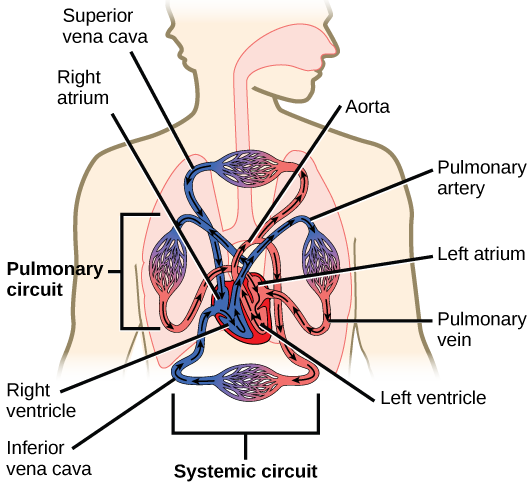
Which of the following statements about the circulatory system is false?
- Blood in the pulmonary vein is deoxygenated.
- Blood in the junior vena cava is deoxygenated.
- Claret in the pulmonary artery is deoxygenated.
- Claret in the aorta is oxygenated.
Structure of the Middle
The heart muscle is asymmetrical as a result of the distance blood must travel in the pulmonary and systemic circuits. Since the correct side of the middle sends blood to the pulmonary circuit it is smaller than the left side which must send blood out to the whole body in the systemic excursion, every bit shown in [link]. In humans, the heart is about the size of a clenched fist; information technology is divided into 4 chambers: two atria and two ventricles. In that location is one atrium and one ventricle on the right side and one atrium and one ventricle on the left side. The atria are the chambers that receive claret, and the ventricles are the chambers that pump blood. The right atrium receives deoxygenated blood from the superior vena cava, which drains blood from the jugular vein that comes from the brain and from the veins that come from the arms, as well as from the inferior vena cava which drains blood from the veins that come up from the lower organs and the legs. In improver, the correct atrium receives blood from the coronary sinus which drains deoxygenated claret from the heart itself. This deoxygenated blood and so passes to the correct ventricle through the atrioventricular valve or the tricuspid valve, a flap of connective tissue that opens in only one direction to prevent the backflow of blood. The valve separating the chambers on the left side of the eye valve is called the biscuspid or mitral valve. After it is filled, the correct ventricle pumps the claret through the pulmonary arteries, by-passing the semilunar valve (or pulmonic valve) to the lungs for re-oxygenation. Later on blood passes through the pulmonary arteries, the correct semilunar valves close preventing the blood from flowing backwards into the correct ventricle. The left atrium then receives the oxygen-rich claret from the lungs via the pulmonary veins. This blood passes through the bicuspid valve or mitral valve (the atrioventricular valve on the left side of the heart) to the left ventricle where the claret is pumped out through aorta, the major avenue of the body, taking oxygenated claret to the organs and muscles of the body. One time blood is pumped out of the left ventricle and into the aorta, the aortic semilunar valve (or aortic valve) closes preventing blood from flowing astern into the left ventricle. This pattern of pumping is referred to equally double circulation and is found in all mammals.
Fine art Connexion
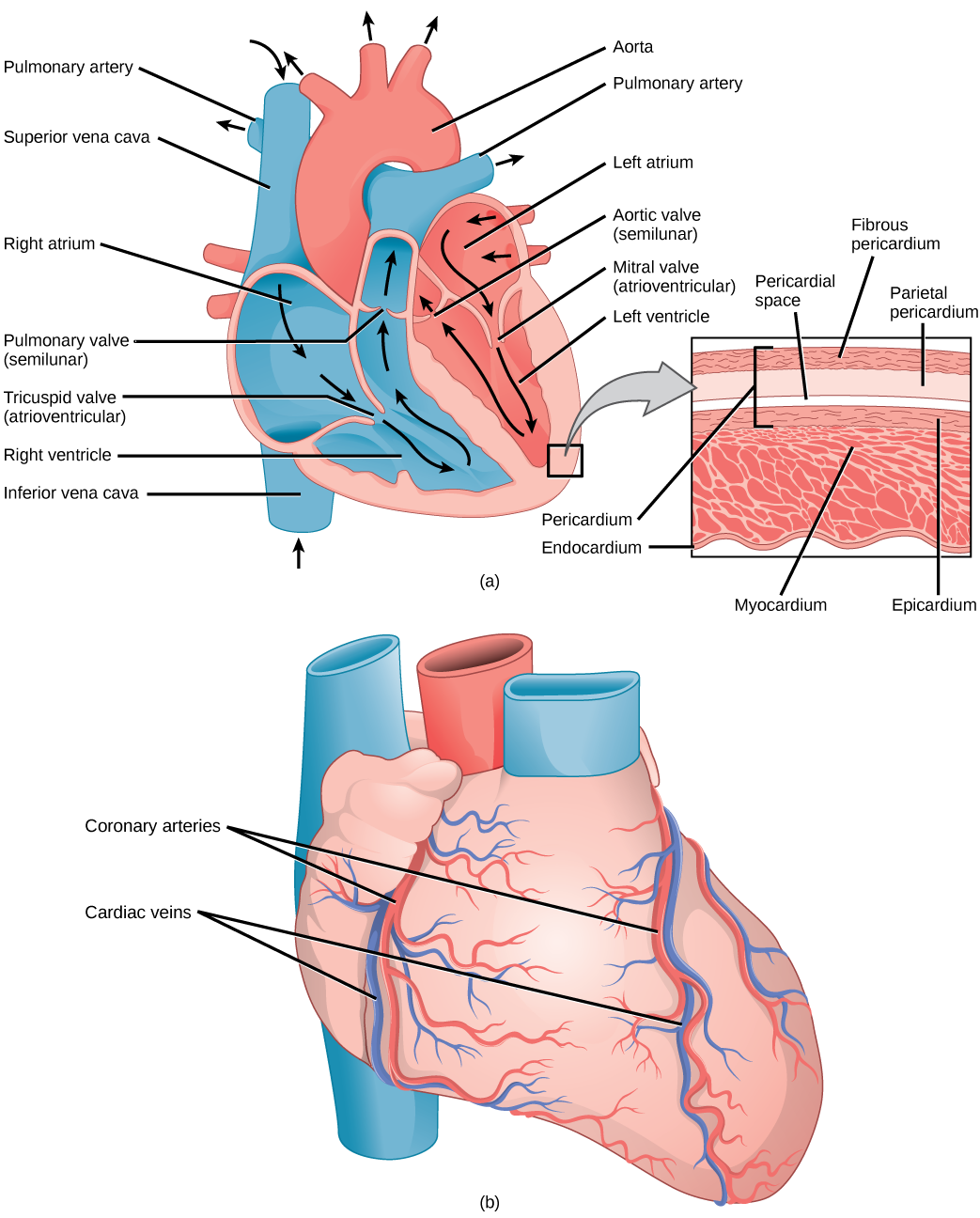
Which of the following statements well-nigh the eye is simulated?
- The mitral valve separates the left ventricle from the left atrium.
- Blood travels through the bicuspid valve to the left atrium.
- Both the aortic and the pulmonary valves are semilunar valves.
- The mitral valve is an atrioventricular valve.
The middle is composed of three layers; the epicardium, the myocardium, and the endocardium, illustrated in [link]. The inner wall of the middle has a lining chosen the endocardium. The myocardium consists of the eye muscle cells that make upwardly the middle layer and the bulk of the heart wall. The outer layer of cells is chosen the epicardium, of which the second layer is a membranous layered structure called the pericardium that surrounds and protects the heart; it allows enough room for vigorous pumping but also keeps the heart in place to reduce friction between the center and other structures.
The centre has its own blood vessels that supply the middle muscle with blood. The coronary arteries branch from the aorta and surround the outer surface of the heart like a crown. They diverge into capillaries where the eye muscle is supplied with oxygen before converging once more into the coronary veins to take the deoxygenated blood back to the right atrium where the blood will be re-oxygenated through the pulmonary circuit. The heart muscle volition die without a steady supply of blood. Atherosclerosis is the blockage of an artery by the buildup of fatty plaques. Considering of the size (narrow) of the coronary arteries and their part in serving the heart itself, atherosclerosis can be deadly in these arteries. The slowdown of claret catamenia and subsequent oxygen deprivation that results from atherosclerosis causes severe pain, known as angina, and complete blockage of the arteries will crusade myocardial infarction: the death of cardiac musculus tissue, normally known as a centre attack.
The Cardiac Cycle
The main purpose of the heart is to pump blood through the trunk; it does and then in a repeating sequence called the cardiac cycle. The cardiac cycle is the coordination of the filling and emptying of the heart of blood by electrical signals that cause the heart muscles to contract and relax. The homo center beats over 100,000 times per day. In each cardiac cycle, the heart contracts (systole), pushing out the blood and pumping it through the trunk; this is followed by a relaxation phase (diastole), where the heart fills with claret, every bit illustrated in [link]. The atria contract at the same fourth dimension, forcing blood through the atrioventricular valves into the ventricles. Closing of the atrioventricular valves produces a monosyllabic "lup" audio. Following a brief delay, the ventricles contract at the aforementioned time forcing blood through the semilunar valves into the aorta and the artery transporting blood to the lungs (via the pulmonary artery). Closing of the semilunar valves produces a monosyllabic "dup" sound.
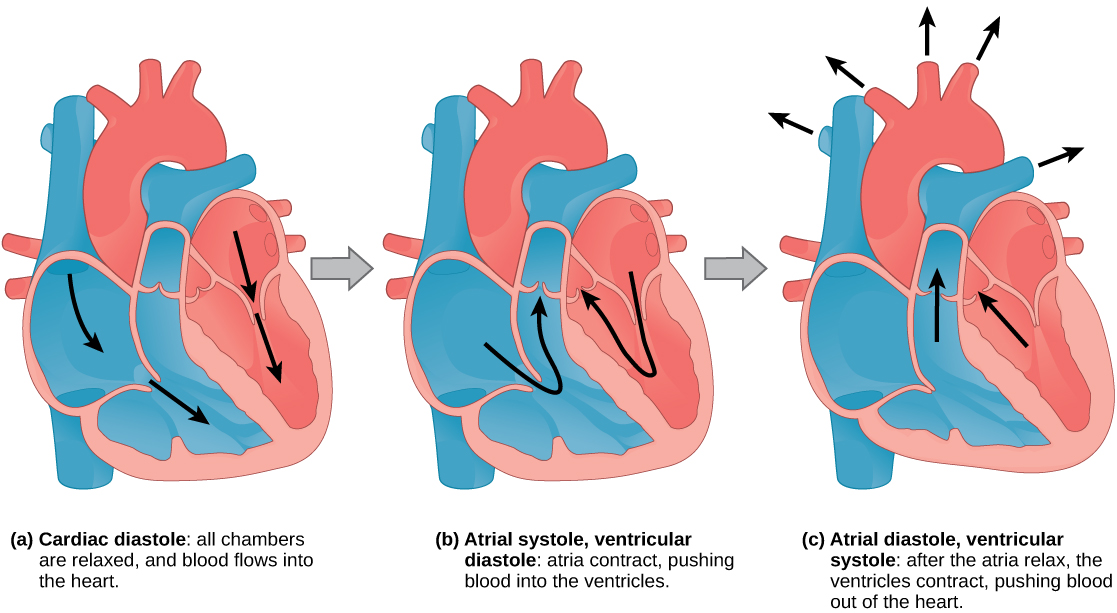
The pumping of the eye is a office of the cardiac muscle cells, or cardiomyocytes, that make up the heart musculus. Cardiomyocytes, shown in [link], are distinctive musculus cells that are striated like skeletal musculus just pump rhythmically and involuntarily like smooth muscle; they are continued by intercalated disks exclusive to cardiac muscle. They are self-stimulated for a period of fourth dimension and isolated cardiomyocytes volition beat if given the correct rest of nutrients and electrolytes.
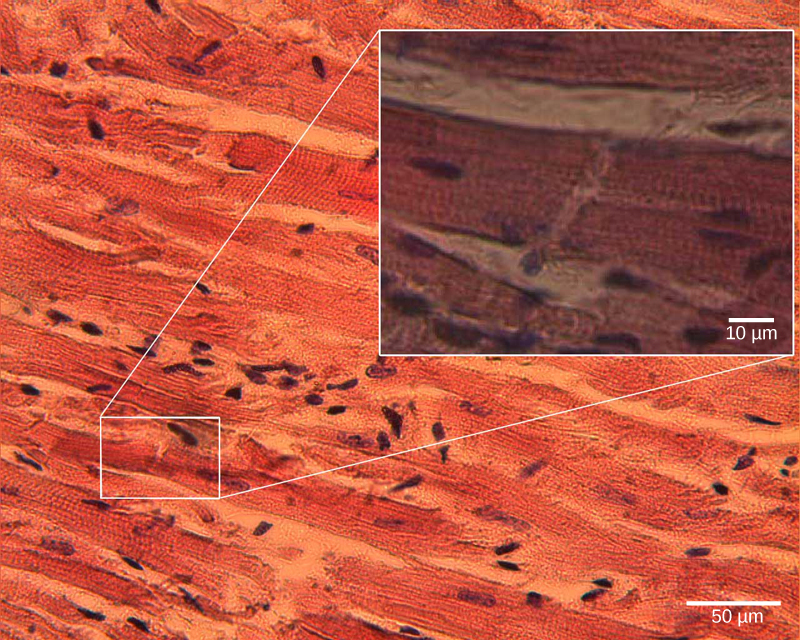
The democratic beating of cardiac musculus cells is regulated by the heart's internal pacemaker that uses electrical signals to time the beating of the heart. The electric signals and mechanical actions, illustrated in [link], are intimately intertwined. The internal pacemaker starts at the sinoatrial (SA) node, which is located near the wall of the right atrium. Electrical charges spontaneously pulse from the SA node causing the two atria to contract in unison. The pulse reaches a 2nd node, chosen the atrioventricular (AV) node, betwixt the right atrium and right ventricle where it pauses for approximately 0.1 second before spreading to the walls of the ventricles. From the AV node, the electrical impulse enters the packet of His, so to the left and right bundle branches extending through the interventricular septum. Finally, the Purkinje fibers conduct the impulse from the noon of the heart upwardly the ventricular myocardium, and then the ventricles contract. This pause allows the atria to empty completely into the ventricles earlier the ventricles pump out the claret. The electrical impulses in the heart produce electric currents that flow through the body and tin can be measured on the peel using electrodes. This data can exist observed equally an electrocardiogram (ECG)—a recording of the electrical impulses of the cardiac muscle.

Link to Learning
 Visit this site to run across the center's "pacemaker" in action.
Visit this site to run across the center's "pacemaker" in action.
Arteries, Veins, and Capillaries
The blood from the heart is carried through the body past a complex network of claret vessels ([link]). Arteries take blood away from the heart. The main artery is the aorta that branches into major arteries that take blood to different limbs and organs. These major arteries include the carotid avenue that takes blood to the brain, the brachial arteries that have blood to the arms, and the thoracic artery that takes blood to the thorax then into the hepatic, renal, and gastric arteries for the liver, kidney, and stomach, respectively. The iliac artery takes blood to the lower limbs. The major arteries diverge into minor arteries, so smaller vessels called arterioles, to reach more securely into the muscles and organs of the body.
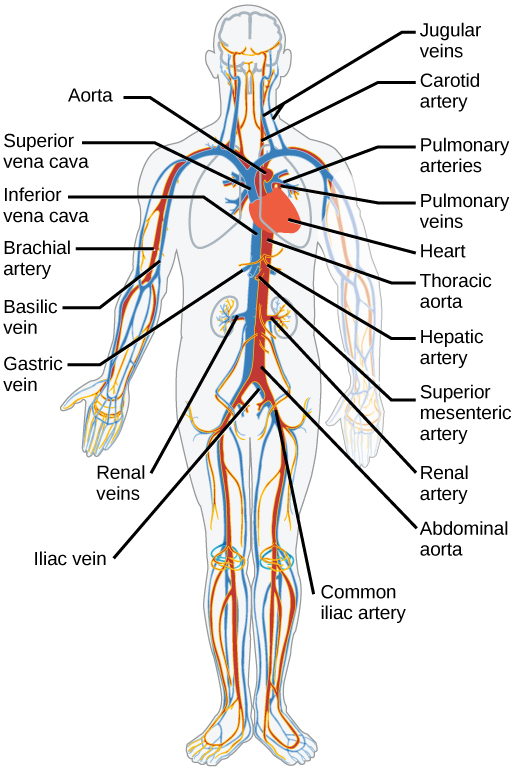
Arterioles diverge into capillary beds. Capillary beds contain a big number (10 to 100) of capillaries that branch among the cells and tissues of the torso. Capillaries are narrow-diameter tubes that tin fit cherry blood cells through in single file and are the sites for the substitution of nutrients, waste, and oxygen with tissues at the cellular level. Fluid also crosses into the interstitial space from the capillaries. The capillaries converge again into venules that connect to minor veins that finally connect to major veins that take claret high in carbon dioxide dorsum to the heart. Veins are blood vessels that bring blood back to the heart. The major veins drain blood from the same organs and limbs that the major arteries supply. Fluid is also brought back to the heart via the lymphatic arrangement.
The construction of the different types of claret vessels reflects their part or layers. In that location are three distinct layers, or tunics, that form the walls of blood vessels ([link]). The first tunic is a polish, inner lining of endothelial cells that are in contact with the reddish blood cells. The endothelial tunic is continuous with the endocardium of the middle. In capillaries, this single layer of cells is the location of diffusion of oxygen and carbon dioxide betwixt the endothelial cells and cerise blood cells, likewise every bit the substitution site via endocytosis and exocytosis. The motion of materials at the site of capillaries is regulated by vasoconstriction, narrowing of the blood vessels, and vasodilation, widening of the blood vessels; this is of import in the overall regulation of blood pressure.
Veins and arteries both have ii farther tunics that surroundings the endothelium: the middle tunic is composed of smooth muscle and the outermost layer is connective tissue (collagen and elastic fibers). The elastic connective tissue stretches and supports the claret vessels, and the smoothen muscle layer helps regulate blood flow by altering vascular resistance through vasoconstriction and vasodilation. The arteries have thicker polish muscle and connective tissue than the veins to accommodate the higher pressure and speed of freshly pumped blood. The veins are thinner walled every bit the force per unit area and rate of period are much lower. In add-on, veins are structurally different than arteries in that veins have valves to prevent the backflow of blood. Because veins have to work against gravity to get blood back to the center, contraction of skeletal muscle assists with the catamenia of blood back to the heart.
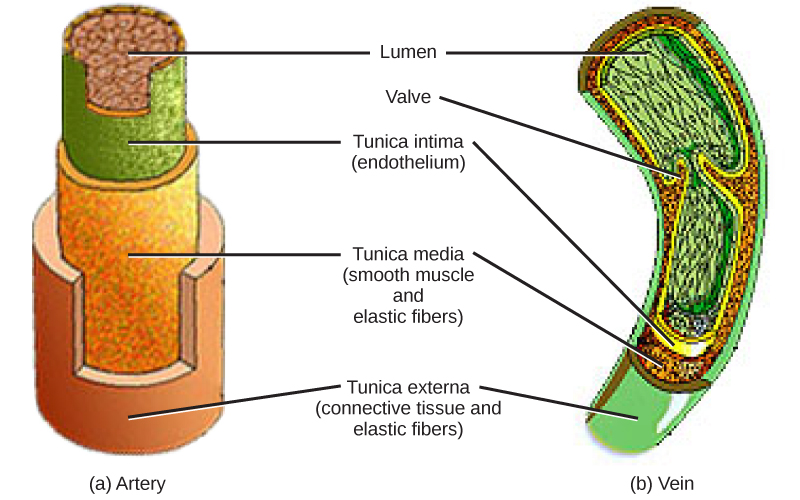
Section Summary
The center muscle pumps blood through three divisions of the circulatory organization: coronary, pulmonary, and systemic. There is i atrium and one ventricle on the right side and one atrium and one ventricle on the left side. The pumping of the middle is a function of cardiomyocytes, distinctive muscle cells that are striated like skeletal muscle but pump rhythmically and involuntarily like smooth muscle. The internal pacemaker starts at the sinoatrial node, which is located near the wall of the right atrium. Electrical charges pulse from the SA node causing the two atria to contract in unison; then the pulse reaches the atrioventricular node betwixt the right atrium and right ventricle. A pause in the electric betoken allows the atria to empty completely into the ventricles before the ventricles pump out the blood. The claret from the heart is carried through the trunk by a circuitous network of blood vessels; arteries have blood away from the middle, and veins bring blood back to the centre.
Art Connections
[link] Which of the following statements almost the circulatory organization is false?
- Claret in the pulmonary vein is deoxygenated.
- Blood in the inferior vena cava is deoxygenated.
- Claret in the pulmonary artery is deoxygenated.
- Blood in the aorta is oxygenated.
[link] C
[link] Which of the following statements about the heart is faux?
- The mitral valve separates the left ventricle from the left atrium.
- Claret travels through the bicuspid valve to the left atrium.
- Both the aortic and the pulmonary valves are semilunar valves.
- The mitral valve is an atrioventricular valve.
[link] B
Review Questions
The eye'south internal pacemaker beats by:
- an internal implant that sends an electrical impulse through the heart
- the excitation of cardiac musculus cells at the sinoatrial node followed by the atrioventricular node
- the excitation of cardiac musculus cells at the atrioventricular node followed by the sinoatrial node
- the action of the sinus
B
During the systolic phase of the cardiac cycle, the heart is ________.
- contracting
- relaxing
- contracting and relaxing
- filling with claret
A
Cardiomyocytes are similar to skeletal muscle considering:
- they beat involuntarily
- they are used for weight lifting
- they pulse rhythmically
- they are striated
D
How practice arteries differ from veins?
- Arteries accept thicker smooth muscle layers to accommodate the changes in force per unit area from the heart.
- Arteries conduct blood.
- Arteries have thinner shine musculus layers and valves and move claret by the activeness of skeletal musculus.
- Arteries are thin walled and are used for gas commutation.
A
Gratuitous Response
Depict the cardiac cycle.
The heart receives an electrical indicate from the sinoatrial node triggering the cardiac musculus cells in the atria to contract. The indicate pauses at the atrioventricular node earlier spreading to the walls of the ventricles so the blood is pumped through the torso. This is the systolic stage. The heart then relaxes in the diastole and fills over again with blood.
What happens in capillaries?
The capillaries basically exchange materials with their environment. Their walls are very thin and are made of one or two layers of cells, where gases, nutrients, and waste are diffused. They are distributed as beds, complex networks that link arteries as well every bit veins.
Glossary
- angina
- pain acquired by fractional blockage of the coronary arteries by the buildup of plaque and lack of oxygen to the centre muscle
- aorta
- major avenue of the body that takes blood away from the centre
- arteriole
- small vessel that connects an avenue to a capillary bed
- artery
- blood vessel that takes blood away from the heart
- atherosclerosis
- buildup of fatty plaques in the coronary arteries in the heart
- atrioventricular valve
- one-way bleary flap of connective tissue betwixt the atrium and the ventricle in the correct side of the heart; also known as tricuspid valve
- bicuspid valve
- (besides, mitral valve; left atrioventricular valve) one-way membranous flap between the atrium and the ventricle in the left side of the heart
- capillary
- smallest blood vessel that allows the passage of individual claret cells and the site of diffusion of oxygen and nutrient exchange
- capillary bed
- large number of capillaries that converge to accept blood to a particular organ or tissue
- cardiac cycle
- filling and emptying the heart of blood by electrical signals that crusade the heart muscles to contract and relax
- cardiomyocyte
- specialized middle muscle jail cell that is striated just contracts involuntarily like smooth muscle
- coronary artery
- vessel that supplies the center tissue with claret
- coronary vein
- vessel that takes blood away from the middle tissue back to the chambers in the center
- diastole
- relaxation phase of the cardiac cycle when the centre is relaxed and the ventricles are filling with blood
- electrocardiogram (ECG)
- recording of the electrical impulses of the cardiac muscle
- endocardium
- innermost layer of tissue in the heart
- epicardium
- outermost tissue layer of the eye
- inferior vena cava
- drains blood from the veins that come from the lower organs and the legs
- myocardial infarction
- (also, middle attack) complete blockage of the coronary arteries and decease of the cardiac muscle tissue
- myocardium
- centre musculus cells that make upward the eye layer and the bulk of the heart wall
- pericardium
- membrane layer protecting the heart; also role of the epicardium
- semilunar valve
- membranous flap of connective tissue betwixt the aorta and a ventricle of the heart (the aortic or pulmonary semilunar valves)
- sinoatrial (SA) node
- the heart'southward internal pacemaker; located near the wall of the right atrium
- superior vena cava
- drains blood from the jugular vein that comes from the brain and from the veins that come from the artillery
- systole
- contraction phase of cardiac cycle when the ventricles are pumping blood into the arteries
- tricuspid valve
- one-way bleary flap of connective tissue between the atrium and the ventricle in the correct side of the centre; besides known equally atrioventricular valve
- vasoconstriction
- narrowing of a blood vessel
- vasodilation
- widening of a blood vessel
- vein
- claret vessel that brings blood back to the centre
- vena cava
- major vein of the torso returning blood from the upper and lower parts of the body; see the superior vena cava and junior vena cava
- venule
- blood vessel that connects a capillary bed to a vein

This work is licensed nether a Creative Commons Attribution 4.0 International License.
You lot tin as well download for free at http://cnx.org/contents/185cbf87-c72e-48f5-b51e-f14f21b5eabd@eleven.two
Attribution:
- For questions regarding this license, please contact partners@openstaxcollege.org.
- If yous apply this textbook as a bibliographic reference, then you lot should cite it every bit follows: OpenStax College, Biological science. OpenStax CNX. http://cnx.org/contents/185cbf87-c72e-48f5-b51e-f14f21b5eabd@eleven.2.
- If you redistribute this textbook in a impress format, and so you must include on every physical page the following attribution: "Download for costless at http://cnx.org/contents/185cbf87-c72e-48f5-b51e-f14f21b5eabd@11.ii."
- If you redistribute part of this textbook, and so yous must retain in every digital format page view (including merely non limited to EPUB, PDF, and HTML) and on every physical printed page the following attribution: "Download for free at http://cnx.org/contents/185cbf87-c72e-48f5-b51e-f14f21b5eabd@11.2."
concepciondaree1968.blogspot.com
Source: https://philschatz.com/biology-book/contents/m44805.html
0 Response to "Hey Travel From the Heart to a Capillary Bed and Back to the Heart Again"
Post a Comment